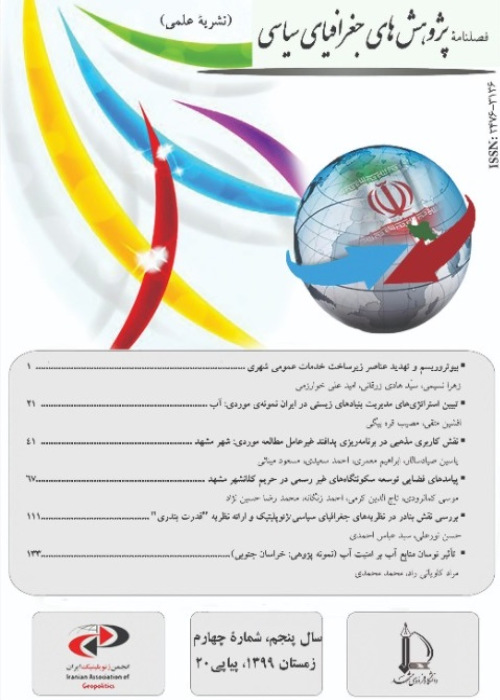The Geopolitical Pathology of Iran's Administrative Divisions in Terms of Spatial Planning
Author(s):
Abstract:
Introduction The political divisions of a country is the political and managerial forms of the national space. Actually, the national administrative divisions determine the position of each part of the terrestrial plane in the spatial structure of the country. Therefore, the administrative divisions should be adjusted and set according to the principles and frameworks of the geographic objectivity for optimal efficiency which is leading to provide a strategic geographic model based on the strengths, weaknesses, opportunities and threats. This focus on the geographical logic in drawing the political boundaries of the interior is based on the view of organizing and aligning the territory at the national, regional and local level. In this regard, one of the important issues that has never been addressed in Iran's development plans is the issue of regionalization and political divisions of space as a framework for territorial planning. Failure to pay attention to this fundamental geographical and political reality is resulted from the weakness of the theoretical foundation as well as the operational structure of development plans in the country. Therefore, the upright and realistic administrative divisions require the generation of theoretical and scientific frameworks based on concepts and geopolitical scales at the local, national, and even transnational level in order to achieve an effective operational and practical structure in the planning of sustainable development subject to the national space. On the other hand, the lack of special attention to the political organization of special planning and administrative divisions also have brought smaller importance of about territorial affairs, and consequently the weakness of the administrative divisions. So that the present paper tends to address the geopolitical pathology of administrative divisions in Iran based upon the geographic logic and realities with the approach of organizing and aligning the land. The basic question of this research is: What are the weaknesses of the administrative divisions in terms of geography and land use? How is its geopolitical consequences and obstacles in the country?
Theoretical Framework The main method of study in geography is combinational. It means that geographers for the recognition and zoning of the area (two major fields of geographic studies) are obliged to study and identify all the features and phenomena in place. Through this study, geographers are enabled to simultaneously recognize the "synoptic" of the all features of the place, and also determine typical feature of the dominant phenomena. Therefore, the recognition of the structural components, elements, and factors that are effective in the environment is a prerequisite and precondition for any thoughtful movement of human beings to carry out a management on the environment. Geography is the science and art of the constructive engagement with the environment and geographical space along with a sagacious management, in order to meet both human requirements and the sustainability of environment leading to achieve a sustainable interaction with geographical space. The result would be the development of humanity along with the environmental sustainability. The relationship between spatial planning and geography can show different implication. Accordingly, geography can be used to explain the type of settlement, population distribution, and activity in the land issues, while the Spatial Planning would be to consider the relationship between these elements. In geography and Spatial Planning, there are three basic elements to be studied: human, space, and activity. In any case, the undeniable subject is the high and sever relationship between "geography" and "Spatial Planning". In other words, it could be stated that geography the most scientifically-based Spatial Planning, and the "Spatial Planning" is the most geographical form of planning.
In political geography or geopolitics, in order to observe geographical logic, it is necessary to pay attention to the planning of land in different stages. Political geography or geopolitics, which studies from boundary and zoning to political behaviors and practices in geographic spaces, requires fulfilment of the geography rules and Spatial Planning concepts. One of the requirements of geopolitics is to consider the realties of the geographic boundaries and zoning, the political divisions, and in general, the political organization of the space, that leads this branch of geographic sciences to the rules and principles of fulfillment of Spatial Planning.
In order to realize the desirable organization of space and to design and operationalize the logical divisions of the country's space on national and local scales, the performance should be on the basis of geopolitical knowledge of space and Spatial Planning. This means the integration of geopolitics and the Spatial Planning as two areas of geographic sciences in order to achieve a political organization of the space which is suitable and favorable for administrative divisions. The focus of this paper is, therefore, on the geopolitical pathology of administrative divisions in Iran, which have been payed no attention to integrate the geopolitics and Spatial Planning issues into the administrative divisions.
Methodology Since this article tends to provide an analysis of the relationship between Spatial Planning and administrative divisions as well as address the pathology of national divisions in terms of Spatial Planning, it is considered as a developmental research which gives its practical value for relevant organizations, and it is an applied research as well. This research is also scribed in a descriptive analytical manner. Data are also collected in a library and documentary manner, and also with reference to reputable online databases such as the Provincial Council and the Ministry of the Interior Affairs.
Findings and Discussion One of the considerable issues regarding country's territorial planning in Iran is the lack of attention to the principles and realities of geography in the country's political divisions. Lack of paying attention to this important issue has led to the formation of a political division not according to the geographical realities and principals. This inconsistency was shaped by the land planning in the modern epoch of the arrival of Pahlavi, and in particular from 1937 onwards. Consequently, in the findings section of the research the authors consider the inconsistency of the current Iranian divisions with regard to the geographical divisions (both natural and human), as well as the lack of attention to the structural factors in the political organization of space and national divisions, including shape, extent, and unbalanced establishment of provincial centers to conclude that the weaknesses and problems in this area directly affects the development, security, and spatial distribution of the country in a negative way.
Theoretical Framework The main method of study in geography is combinational. It means that geographers for the recognition and zoning of the area (two major fields of geographic studies) are obliged to study and identify all the features and phenomena in place. Through this study, geographers are enabled to simultaneously recognize the "synoptic" of the all features of the place, and also determine typical feature of the dominant phenomena. Therefore, the recognition of the structural components, elements, and factors that are effective in the environment is a prerequisite and precondition for any thoughtful movement of human beings to carry out a management on the environment. Geography is the science and art of the constructive engagement with the environment and geographical space along with a sagacious management, in order to meet both human requirements and the sustainability of environment leading to achieve a sustainable interaction with geographical space. The result would be the development of humanity along with the environmental sustainability. The relationship between spatial planning and geography can show different implication. Accordingly, geography can be used to explain the type of settlement, population distribution, and activity in the land issues, while the Spatial Planning would be to consider the relationship between these elements. In geography and Spatial Planning, there are three basic elements to be studied: human, space, and activity. In any case, the undeniable subject is the high and sever relationship between "geography" and "Spatial Planning". In other words, it could be stated that geography the most scientifically-based Spatial Planning, and the "Spatial Planning" is the most geographical form of planning.
In political geography or geopolitics, in order to observe geographical logic, it is necessary to pay attention to the planning of land in different stages. Political geography or geopolitics, which studies from boundary and zoning to political behaviors and practices in geographic spaces, requires fulfilment of the geography rules and Spatial Planning concepts. One of the requirements of geopolitics is to consider the realties of the geographic boundaries and zoning, the political divisions, and in general, the political organization of the space, that leads this branch of geographic sciences to the rules and principles of fulfillment of Spatial Planning.
In order to realize the desirable organization of space and to design and operationalize the logical divisions of the country's space on national and local scales, the performance should be on the basis of geopolitical knowledge of space and Spatial Planning. This means the integration of geopolitics and the Spatial Planning as two areas of geographic sciences in order to achieve a political organization of the space which is suitable and favorable for administrative divisions. The focus of this paper is, therefore, on the geopolitical pathology of administrative divisions in Iran, which have been payed no attention to integrate the geopolitics and Spatial Planning issues into the administrative divisions.
Methodology Since this article tends to provide an analysis of the relationship between Spatial Planning and administrative divisions as well as address the pathology of national divisions in terms of Spatial Planning, it is considered as a developmental research which gives its practical value for relevant organizations, and it is an applied research as well. This research is also scribed in a descriptive analytical manner. Data are also collected in a library and documentary manner, and also with reference to reputable online databases such as the Provincial Council and the Ministry of the Interior Affairs.
Findings and Discussion One of the considerable issues regarding country's territorial planning in Iran is the lack of attention to the principles and realities of geography in the country's political divisions. Lack of paying attention to this important issue has led to the formation of a political division not according to the geographical realities and principals. This inconsistency was shaped by the land planning in the modern epoch of the arrival of Pahlavi, and in particular from 1937 onwards. Consequently, in the findings section of the research the authors consider the inconsistency of the current Iranian divisions with regard to the geographical divisions (both natural and human), as well as the lack of attention to the structural factors in the political organization of space and national divisions, including shape, extent, and unbalanced establishment of provincial centers to conclude that the weaknesses and problems in this area directly affects the development, security, and spatial distribution of the country in a negative way.
Keywords:
Language:
Persian
Published:
Research Political Geography, Volume:1 Issue: 3, 2016
Pages:
155 to 186
magiran.com/p1752014
دانلود و مطالعه متن این مقاله با یکی از روشهای زیر امکان پذیر است:
اشتراک شخصی
با عضویت و پرداخت آنلاین حق اشتراک یکساله به مبلغ 1,390,000ريال میتوانید 70 عنوان مطلب دانلود کنید!
اشتراک سازمانی
به کتابخانه دانشگاه یا محل کار خود پیشنهاد کنید تا اشتراک سازمانی این پایگاه را برای دسترسی نامحدود همه کاربران به متن مطالب تهیه نمایند!
توجه!
- حق عضویت دریافتی صرف حمایت از نشریات عضو و نگهداری، تکمیل و توسعه مگیران میشود.
- پرداخت حق اشتراک و دانلود مقالات اجازه بازنشر آن در سایر رسانههای چاپی و دیجیتال را به کاربر نمیدهد.
In order to view content subscription is required
Personal subscription
Subscribe magiran.com for 70 € euros via PayPal and download 70 articles during a year.
Organization subscription
Please contact us to subscribe your university or library for unlimited access!



